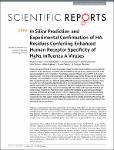In Silico Prediction and Experimental Confirmation of HA Residues Conferring Enhanced Human Receptor Specificity of H5N1 Influenza A Viruses
Schmier, Sonja
Mostafa, Ahmed
Haarmann, Thomas
Bannert, Norbert
Ziebuhr, John
Veljkovic, Veljko
Dietrich, Ursula
Pleschka, Stephan
Newly emerging influenza A viruses (IAV) pose a major threat to human health by causing seasonal epidemics and/or pandemics, the latter often facilitated by the lack of pre-existing immunity in the general population. Early recognition of candidate pandemic influenza viruses (CPIV) is of crucial importance for restricting virus transmission and developing appropriate therapeutic and prophylactic strategies including effective vaccines. Often, the pandemic potential of newly emerging IAV is only fully recognized once the virus starts to spread efficiently causing serious disease in humans. Here, we used a novel phylogenetic algorithm based on the informational spectrum method (ISM) to identify potential CPIV by predicting mutations in the viral hemagglutinin (HA) gene that are likely to (differentially) affect critical interactions between the HA protein and target cells from bird and human origin, respectively. Predictions were subsequently validated by generating pseudotyped retrovirus particles and genetically engineered IAV containing these mutations and characterizing potential effects on virus entry and replication in cells expressing human and avian IAV receptors, respectively. Our data suggest that the ISM-based algorithm is suitable to identify CPIV among IAV strains that are circulating in animal hosts and thus may be a new tool for assessing pandemic risks associated with specific strains.
No license information
Related Items
Show related Items with similar Title, Author, Creator or Subject.
-
2016-10-13ZeitschriftenartikelImproving influenza virological surveillance in Europe: strain-based reporting of antigenic and genetic characterisation data, 11 European countries, influenza season 2013/14 Broberg, E.; Hungnes, Olav; Schweiger, Brunhilde; Prosenc, Katarina; Daniels, R.; Guiomar, R.; Ikonen, N.; Kossyvakis, A.; Pozo, Francisco; Puzelli, S.; Thomas, I.; Waters, A.; Wiman, Å.; Meijer, AdamInfluenza antigenic and genetic characterisation data are crucial for influenza vaccine composition decision making. Previously, aggregate data were reported to the European Centre for Disease Prevention and Control by ...
-
2011-04-23ZeitschriftenartikelAvian influenza virus risk assessment in falconry Kohls, Andrea; Hafez, Hafez Mohamed; Harder, Timm; Jansen, Andreas; Lierz, Peter; Lüschow, Dörte; Schweiger, Brunhilde; Lierz, MichaelBackground: There is a continuing threat of human infections with avian influenza viruses (AIV). In this regard falconers might be a potential risk group because they have close contact to their hunting birds (raptors ...
-
2011-09-14ZeitschriftenartikelInfluenza B Virus With Modified Hemagglutinin Cleavage Site as a Novel Attenuated Live Vaccine Stech, Jürgen; Garn, Holger; Herwig, Astrid; Stech, Olga; Dauber, Bianca; Wolff, Thorsten; Mettenleiter, Thomas C.; Klenk, Hans-DieterBackground: Both pandemic and interpandemic influenza is associated with high morbidity and mortality worldwide. Seasonal epidemics are caused by both influenza A and B virus strains that cocirculate with varying predominance ...

